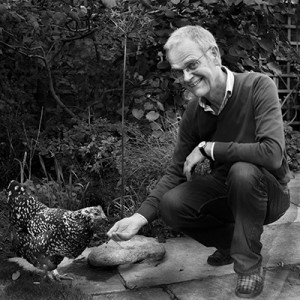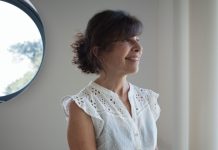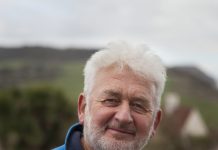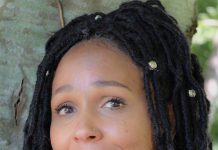Robin Mills went to Dorchester to meet Dr Richard Sloan. This is his story.
“Both my parents are from Northern Ireland originally. My father qualified in medicine in Belfast then became a junior partner in general practice “across the water” in Accrington, Lancashire. He and my mother moved to Germany in the early 1950s for his National Service as an Army doctor, and they had been posted to the Netherlands when I was born. I was just 6 months old when they took me back to England. The customs officer in Harwich cheekily put a white chalk cross on my bottom as an item they’d left England without, but were now importing.
Back in Accrington, we lived above the surgery in a typical north of England terraced street. I went to primary school right next to Accrington Stanley football ground. I can remember when they made the headlines on the national news when they dropped out of the 4th Division of the League having become insolvent. From that came the famous advert for milk, in which one football-mad Scouse boy says to another, “If you don’t drink up your milk you’ll end up playing for Accrington Stanley”. His mate says “Who?” to which the response was “Exacly!” Accrington was also where they made the world-famous Nori bricks. The story goes that the man who made the template to stamp the bricks with got it back to front; renowned for their strength, they were supposed to be called “Iron” bricks but the name stuck.
I went away to Lancaster Royal Grammar School as a boarder, where I was keen on sport, particularly rugby and rowing. I was reasonably good at cricket initially, but finding I couldn’t see the ball too well led me to the reluctant discovery that I was becoming short-sighted and needed glasses—more fashionable now than then. From quite an early age I’d wanted to follow in my father’s footsteps and study medicine, specifically general practice, though academically I was a bit of a plodder; I struggled with chemistry but much to my surprise, I managed to scrape through and was able to apply. At the time, some London medical schools were well-known for their rugby teams, and St Mary’s Hospital, Paddington was no exception, having had some famous Welsh international players including the great JPR Williams in their team. So, that was where I started my medical training in 1971. Unfortunately, my rugby career was short-lived due to a recurrent shoulder dislocation. The training was 5 years, plus a year’s house jobs around London hospitals; then I did a further 4 year’s GP training in Swansea, and that was where I met my lovely future wife Sue. She came from Sheffield in Yorkshire, and I was from Lancashire, but we quickly buried the hatchet. At the end of my training, we decided to take a year out before settling down and I found a post in Napier Hospital, New Zealand, which was really good experience for me as a new doctor, and a wonderful part of the world to spend time. We came back to the UK in 1983, and got married in September of that year. Looking round for partnerships to join, one came up in Maghull, Merseyside. It was a well-run, innovative practice, so I felt lucky to be appointed there. We really enjoyed Liverpool, the lively atmosphere and the humour. Liverpudlians are passionate supporters of the NHS, with its promise to look after them from the cradle to the grave or, as they’d put it, “from the sperm to the werm”.
As the years went by, I was finding general practice more and more stressful. You were on the go from the minute you walked in the surgery until late in the evening, and I suppose it wasn’t all that I’d been hoping, having viewed it through my father’s eyes. Done well, I’ve got huge respect for general practice as a speciality despite the frequent criticisms voiced today. There is the responsibility of picking out, with limited information, the relatively rare situations where urgent action is crucial, from the majority which will either resolve spontaneously or with relatively straightforward treatment. This has to be balanced against referring everyone to hospital “just in case”; not always easy to safely achieve. Expectations of politicians and the public have been inexorably rising over the years—some for the better but others unrealistic. In retrospect, I was trying to do too much and beginning to burn out, and in a quandary as to what to do.
During my GP training in Swansea, I’d spent some time gaining experience in palliative care at the local hospice. It turned out to be a huge revelation to me as, in common with most people, I wrongly assumed this was only for people in their final days of life. The nurturing environment and consideration of all aspects of the person’s life—the psychological, the social and the practical—often replaced what had been missing from mainstream medical care to date and made all the difference. I got great satisfaction from practicing palliative care in general practice and found that aspect of my job very rewarding. However, I was apprehensive about what it would be like doing this full-time. I sought advice from people in the field who said that, although there’s inevitable sadness in dealing with people towards the end of their lives, the increased time for individual patients and families made the job much more satisfying. This especially appealed to me. I resigned from my practice and we moved to London while I retrained at St Christopher’s Hospice, founded by Dame Cecily Saunders as the first modern-day hospice.
I had found my niche and at the end of my training, an advertisement appeared in the BMJ for the Medical Director’s post at a new hospice under construction in somewhere called Dorchester. We’d always assumed we’d probably head back up north to work, but at Sue’s suggestion we came to Dorset for a week-end to see what it was like. We stayed at a B&B run by Doris Haggett in Crossways. She knew all about the project to build the Joseph Weld Hospice, and in those couple of days really sold us Dorset. So, after I was eventually appointed, we came to live in this beautiful unspoilt county in 1993. The hospice was very innovative for those days in that it actively promoted help not only for patients with cancer, but also for those with any other end-stage illness. Because of personal experiences, it was a charismatic leading light in the local community, John Greener, who was determined that West Dorset should have its own facility. Involving many people from all backgrounds in its planning and fund-raising, what would normally take 10-15 years from inception to opening took only an incredible 4. Several years later, the Hospice joined forces with the Cancer Care Dorset home-care nurses and Trimar, the day hospice in Weymouth, under the new banner of Weldmar Hospicecare Trust. This produced the integrated and comprehensive service which continues to develop today.
After 20 years, I retired as Medical Director at the end of May. Over the years, my special interest has been the challenge of caring for patients with Motor Neurone Disease. We have developed links with the local neurology and other services to provide much more comprehensive support to patients and their families from any time after diagnosis. I’ve been regularly involved with the education of healthcare professionals in MND both in this country and abroad, most recently in Moscow, where an enthusiastic group is striving to improve very sparse facilities. I hope that I will be able to continue to hand on my experience in this way. I miss the fun I had with my many work colleagues day-to-day and am learning to adapt to a completely new structure of life—quite a shock at first. But I’ve always had hobbies. Photography is one, which came from my father who taught me darkroom work, although it’s all digital now. And choral singing; Sue did an evening class back in Liverpool, and loved it. She said why don’t we join a choir, so we were welcomed along to a rehearsal of the Liverpool Welsh Choral Union, who held concerts in the prestigious Philharmonic Hall. I’ll never forget the thrilling moment when the whole choir first erupted into song around us. We’ve been members of Dorchester Choral Society for the last 20 years. It’s a great antidote to life’s stresses and challenging both physically and intellectually. I’ve also been doing more of my main form of exercise, cycling. I got fit for the London 100 mile ride in August, the cycling equivalent of the marathon, raising sponsorship for the hospice. I look forward to exploring more of life’s pleasures now that I’ve got the time.”










